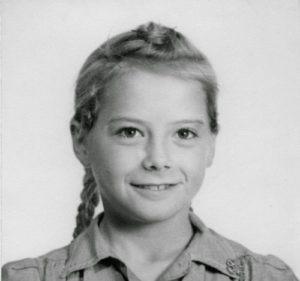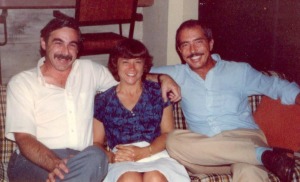
This piece first appeared in the Project Redwood blog.
In the early 1990s, Donna Davis Allen was at a crossroads. After a decade as a key member of a team that grew a Bay Area insurance start-up into an acquisition prize, she never-the-less felt unsatisfied.
It wasn’t a full-fledged crisis, exactly, but an increasingly persistent inner voice urged her to let loose the security blanket of a conventional job and reach for something different.
Tragedy, happenstance, and Donna’s innate loyalty and penchant for hard work ultimately combined to uncover an at-times difficult but always gratifying path. She’s dedicated much of the last 21 years to raising awareness and funds to battle the AIDS/HIV epidemic through her work with the foundation Until There’s a Cure.
Her years of learning about non-profit administration and grant making there have also paid off for another non-profit, our own Project Redwood. As a founding partner in 2005, Donna helped get things going. Now, after eight years of co-leading our Grant Review Committee, she’s committed to serve for the next two as Board of Directors Co-Chairperson, and to help Project Redwood address the thorny questions that any growth-seeking enterprise faces.
As a student thirty-five years ago at the Stanford Graduate School of Business (GSB), Donna, like everyone, was helplessly unaware of Acquired Immune Deficiency Syndrome (AIDS), and the ways in which it would subsequently affect her life. The infectious disease is caused by a virus, acronym HIV, that attacks and impairs human immune system cells, leaving the body progressively susceptible to disease. Evidence of AIDS first visibly bubbled up in the United States in the early 1980s. Clusters of cases of pneumocystis pneumonia, other opportunistic infections, and the rare cancer Kaposi’s sarcoma began to appear in California and New York City. The underlying disease was identified and named in 1982; the virus that causes it was isolated the following year. By then, though, thousands were infected, and no treatments loomed on the horizon.
Donna’s brother, David, died from complications of AIDS in 1986, at age 44. She recalls him as vibrant and dynamic, a renaissance man who had a Masters Degree in Choral Conducting but who also was a writer and a businessman.
“It was really bad, it went into his brain,” Donna says of her brother’s final struggle, “He lost his mental capacity. He couldn’t play the piano anymore, or read, or write. So it was very sad.” Unfortunately, no real treatments were available to help David; the first anti-retroviral drugs to treat AIDS were not available until 1987.
A few years later, at about the time Donna was taking stock and reassessing her future, two Woodside, California mothers were forming Until There’s a Cure, motivated by their desire to spare their own children, and others, of the possibility of the agonizing deaths that too often followed HIV infection. When Donna found them, their then tiny non-profit seemed to be a fitting outlet for her restlessness and grief, and a receptive setting for her business acumen.
She started out doing a little of this and that around the office, assisting and consulting as needed. Soon, though, Donna was elected to the Board of Directors, which she now Chairs.
Until There’s a Cure is both a grant-making and outreach organization that channels its resources to prevention education, care and services for those suffering from infection, and vaccine development. So far, they’ve donated more than $11 million to dozens of organizations to fund initiatives like hospice care, case management, summer camps for HIV-positive kids, AIDS education through childrens’ theater, and forward-looking research projects.
Its unique approach to fundraising was groundbreaking at Until There’s a Cure’s inception 21 years ago. Most of its granting and operating monies are raised through product sales. “We were the first organization to design, create, and sell a bracelet for a cause,” says Donna, “back in 1993 before Lance Armstrong or any of the others.”
The original bracelet was an elegant cuff, rendered in silver plate, sterling, or 18 carat gold, with a small AIDS ribbon on the outside and panels for engraving on the inside.
Over the years, the product line has expanded to include a variety of affordable bracelets, including some that are made by African women in communities deeply impacted by HIV. “We create a marketplace for the artisans primarily through our website, until.org,” says Donna, “they get the income from making the bracelets, and we can donate funds for prevention to their communities as well.”
Until There’s a Cure has also formed a close and enduring partnership with the San Francisco Giants of Major League Baseball. This past summer, the Giants hosted their 21st annual AIDS Awareness Day. Until There’s a Cure sells their jewelry and other products during the game, and in a pre-pitch ceremony the Gaints officially award funds to a grantee that’s been collaboratively selected by the two organizations. In addition, the Giants allow Until There’s a Cure to pick a person to throw out the first pitch of the game, a perk that’s been a wonderfully successful means of thanking volunteers.
Donna herself has been chosen twice. She admits to practicing a bit, but credits most of her success in getting the ball over the plate to past experience playing softball. She was a member of the Stanford GSB women’s softball team, after all.
While much progress has been made in treating AIDS, and AIDS related deaths are declining, new infections continue, particularly in underdeveloped parts of the world. According to the World Health Organization, 35 million people are right now infected with HIV, and 19 million of those do not know it, including many in the United States. Today, HIV kills more people than any other infectious disease. Populations in sub-Saharan Africa, and young women and adolescent girls, are disproportionately at risk.
“There is a complacency about AIDS now, people don’t think it affects them, especially in the United States,” says Donna, “so our challenge is to keep the public aware. We are fighting for this cause to hopefully someday put ourselves out of business.”
Donna devotes another substantial chunk of her time, luckily, to Project Redwood. She was a speaker on the “Giving Back” panel at the Stanford GSB Class of 1980 25th reunion that originally inspired Project Redwood. From day one, she and a dozen or so former classmates wrestled the issues of founding a non-profit, sorting out priorities, forming a structure, and developing a granting process. When Project Redwood was set up and ready to go after about a year, Donna guided (with some help) eight funding cycles and several growth spurts.
Now Project Redwood faces the challenge of creating a legacy, of searching for ways to continue, long term, the fight against extreme poverty, and also grow the organization’s reach. In the next two years, Donna hopes to help her Project Redwood partners work through questions like: Should Project Redwood adopt and mentor a younger alumni class? How about inviting in donors outside of the current eligible partnership, which is now limited to members of the Class of 1980? Is it feasible to hire professional staff and seek to significantly expand by going after large grants and endowment funds? Or, is continuing the status quo perhaps the best way forward?
While these questions are not easy, Donna is ready for the conference calls, the email back-and-forth, the thinking and rethinking, and, yes, the disagreements that finding consensus entails.
But, after 20 plus years of unwavering commitment to non-profit work, including ten with Project Redwood, the more relevant questions for Donna may be: Why do you do it? What keeps you going?
Her answer will most surely be that she does it because she loves working with people and particularly with her former classmates, getting to know them better, and developing new or deeper friendships.
However, the keystone of what she’s learned from her work with both Project Redwood and Until There’s a Cure is more important to her even than personal relationships. “It’s just realizing that a small group of people with a real passion can touch many peoples’ lives,” says Donna, “A small organization can develop a big voice.”
For more information about Until There’s a Cure, visit until.org or follow their Twitter outreach through @UntilOrg.

